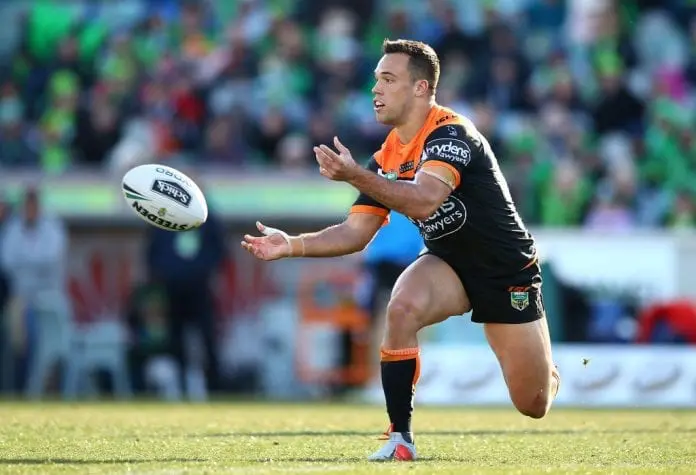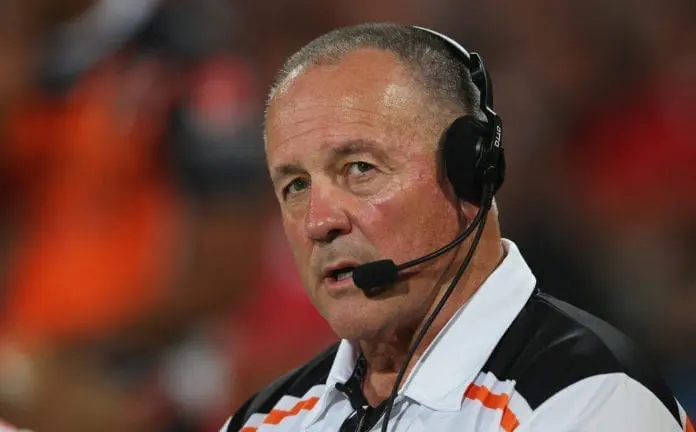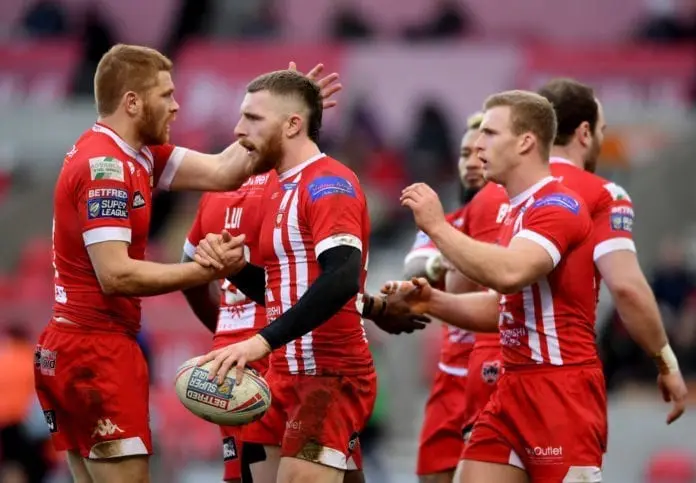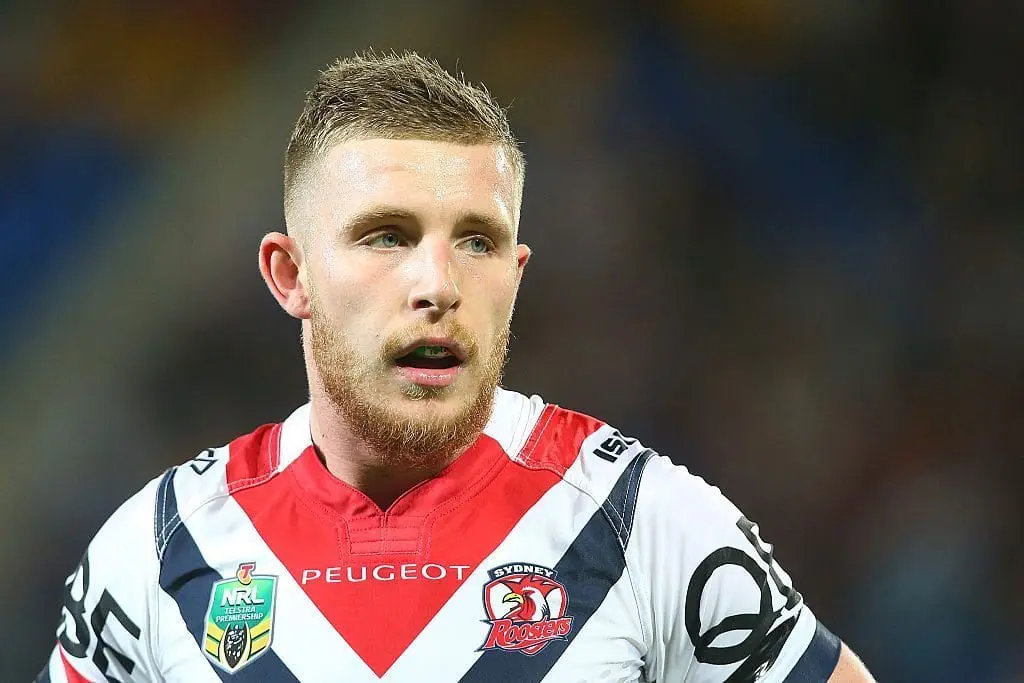Following weeks that felt like months, the player swap deal between the Newcastle Knights and Wests Tigers is complete after Jackson Hastings and David Klemmer each made the opposite move.
For most of the protracted saga, though, Hastings was not the Knights' initial target. The Newcastle club made repeated and well-publicised overtures as they tried to secure long-term Tigers No.7 Luke Brooks.
There were many indications that Brooks was the prime target for the Hunter team. It was reported (and subsequently denied) that he had asked for a release to join them last off-season, and Andrew Johns was effusive in his praise of Brooks, claiming that the Knights could help him realise his long-unfulfilled potential.
The Tigers were then put in an awkward spot as they faced the prospect of losing the man they'd put so much faith and effort into.
The Brooks conundrum
If they'd let Brooks go and he succeeded in Newcastle, what would that say about the Wests Tigers? We know they've been a basket-case in recent years, but if the one player who has remained a constant throughout it all reaped immediate success elsewhere, that would be a damning indictment of the organisation.
Brooks has copped a lot of the flak for poor results and his ongoing finals absence. It might not be fair, but it's harder to target the coaches when he's outlasted so many.
Brooks has outlasted Mick Potter, Jason Taylor, Michael Maguire and Ivan Cleary, as well as a number of interim coaches. For all the criticism Brooks receives, not one of these mentors has been able to muster a winning record in the last 10 years.

Conversely, with such a significant rate of turnover in the playing group and the coaching staff, Brooks has remained a constant. Though the club has tried a number of recruitment tactics to support him, the results have still not been forthcoming.
In his nine full seasons in the NRL, he's not returned a winning record. The closest he came was a 50-50 split in 2018 – the season he was named Halfback of the Year. His overall win rate after 189 NRL appearances is 38.6 per cent.
It doesn't make for inspiring reading, but Brooks still has plenty of value for the club, winning three of the last five Kelly-Barnes awards as the club's Player of the Year in 2018, 2019 and 2021 (with Daine Laurie).
The Tigers have done everything they can to get the best out of their halfback and, in turn, get the best out of their team. It hasn't worked.
Can Sheens make a difference?
He's the most successful coach in the club's history and not just because of his premiership. With 250 games at the helm, he's coached the Tigers at least three times longer than the next nearest coach (Maguire with 80 games). He's also the closest to a winning record, with a 48.8% success rate across 10 years.
But Sheens has never worked directly with Luke Brooks. Though the coach was directly involved in convincing a young Brooks to commit to the Tigers, Sheens left at the end of 2012 and Brooks made his NRL debut in 2013.
For all the optimism that the potential arrival of John Bateman will bring Tigers fans on top of new additions Isaiah Papali'i, David Klemmer and Api Koroisau, so much of their future still relies on the halfback.

While the coach is typically the first one under pressure for failing to get results, you can't help but feel Brooks might be standing ahead of Sheens in that line at the Tigers.
Tigers fans who remember Sheens will know what he's capable of and are likely to be more patient in allowing him time to succeed, but those fans have already been through the last, fruitless decade with Brooks at the helm, and are unlikely to have that same patience for him if results don't quickly improve.
Steal City
It's a simple tactic to approach any negotiation knowing exactly what you want, and start by aiming high so that your preference actually seems like a compromise.
Given Sheens repeatedly claimed the Knights never made a formal offer for Brooks, there's a good chance they went into their negotiations with the Tigers with Jackson Hastings already in mind.
There's no doubt the Knights were interested in Brooks, but the Tigers were clear from the outset that he was unlikely to be moved.
But a talented half who has regularly endured scapegoating and massive scrutiny, who is likely to have a point to prove provided he can secure a regular role? That's an attractive prospect.
While he probably doesn't need sympathy, I feel for Jackson Hastings.
Despite some attitude problems – the same as the majority of young men when they enter the NRL – Hastings has inarguable talent. But as the son of a former Roosters legend Kevin Hastings, he was also under inarguable pressure from the moment he made his NRL debut for the Tri-colours in 2014.

In his first full season in 2015, he played 17 games, regularly off the bench, as the Roosters marched all the way to the minor premiership and preliminary final. With James Maloney leaving in 2016, it seemed a natural choice that Hastings would play alongside Mitchell Pearce.
Was it Hastings' fault that Pearce decided to simulate an obscene act on a dog and earn himself an eight-week ban to kick off the 2016 season? Pearce wasn't even around the club to work with Hastings after heading to an overseas rehab facility.
Was it Hastings' fault that the game's premier fullback, Roger Tuivasa-Sheck, left the club at the end of 2015 for a return to New Zealand?
It might as well have been.
The club also lost Michael Jennings, who had contributed 44 tries in three years at the Tri-colours and had a rookie by the name of Latrell Mitchell taking over at the back in his first season.
It's worth mentioning the halves partners Hastings worked with during that time. Jayden Nikorima played seven games alongside Hastings in 2016. He didn't return to the NRL until 2022.
Aidan Guerra was one of the game's most respected back-rowers, but after a three-game stint at five-eighth alongside Hastings in 2016, he never played the role again.
Ryan Matterson was handed his NRL debut next to Hastings in the five-eighth role. No matter how well he played, he was a rookie, and we've seen since that he's far better utilised as a back-rower.
All of that mattered little. After a poor start to the year, reports emerged about instability in the dressing room, with disagreements and egos disrupting any hopes of a turnaround.
When Pearce came back, the results didn't really improve. Reports of division continued, Hastings was demoted to the Wyong Roos in favour of Connor Watson, and the Roosters finished 15th. It was their worst finish since the wooden spoon of 2009.
After three minor premierships in a row, it was a jarring result.
The Toxic Avenger
Despite Pearce's ban, despite the loss of experience, despite the constantly-changing halves combinations and the talented but inexperienced youth prospects, Hastings was branded a toxic influence after putting senior players offside and he was released from the final year of his contract.

When similar circumstances curtailed his time at Manly, it started to look like maybe he was the problem after all – but as we've all learned in the last few years, Manly isn't the most stable working environment in the NRL.
Hastings' NRL career was on life support before the Super League came calling.
His time in the UK was remarkably different. Away from the constant scrutiny of Australian media, Hastings flourished, taking Salford to a historic Super League Grand Final appearance and doing the same with Wigan a year later. He was named the Man of Steel in 2019.
When his return to Australia was announced, there was excitement. A half with finals experience in the NRL and England was bound to be a valuable asset to any club.
He was even the determining factor in the Tigers' first win of the season, kicking the match-winning field goal against Parramatta.
Unfortunately, his efforts weren't enough to turn the club into a threat, but he was still seen as a positive influence as chaos engulfed the club and Maguire was sacked.
Despite making inroads in the halves, he was moved to lock just over a month later at the behest of Sheens. Three games later, Hastings broke his leg in a hip-drop tackle by Patrick Carrigan.
None of us knew it then, but that would be his last act as a Tigers player.
At least this time there was no suggestion of a falling out or issues among the playing group. Most Tigers fans, in fact, have been disappointed by the move, seeing Hastings as a meaningful addition to the squad and frustrated by the decision to move him on so quickly.
Now, at Newcastle, Hastings has another chance to start again – and so do the Knights.
Newcastle was ready to fight for a 189-game NRL veteran who has spent the entirety of his career in one system, has never played finals football and has never been selected to an Origin or international team despite his Halfback of the Year award.
Instead, they got a player with 149 games of first-class experience across five different organisations, with 14 games of finals experience in both the NRL and England, as well as the game's highest honour in the Northern hemisphere. He's also played for Great Britain – demonstrating the wealth of experience he's amassed in a variety of settings and structures.
Newcastle might not have got the player they wanted, but in Jackson Hastings, they may have got something better.
Time will tell.























